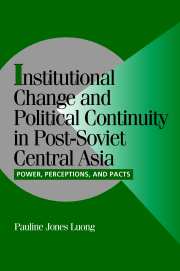 Institutional Change and Political Continuity in Post-Soviet Central Asia
Institutional Change and Political Continuity in Post-Soviet Central Asia Book contents
- Frontmatter
- Contents
- Tables and Figures
- Note on Transliteration
- Acronyms
- Acknowledgments
- 1 THE CONTINUITY OF CHANGE: OLD FORMULAS AND NEW INSTITUTIONS
- 2 EXPLAINING INSTITUTIONAL DESIGN IN TRANSITIONAL STATES: BEYOND STRUCTURE VERSUS AGENCY
- 3 SOURCES OF CONTINUITY: THE SOVIET LEGACY IN CENTRAL ASIA
- 4 SOURCES OF CHANGE: THE TRANSITIONAL CONTEXT IN CENTRAL ASIA
- 5 ESTABLISHING AN ELECTORAL SYSTEM IN KYRGYZSTAN: RISE OF THE REGIONS
- 6 ESTABLISHING AN ELECTORAL SYSTEM IN UZBEKISTAN: REVENGE OF THE CENTER
- 7 ESTABLISHING AN ELECTORAL SYSTEM IN KAZAKHSTAN: THE CENTER'S RISE AND THE REGIONS' REVENGE
- 8 INSTITUTIONAL CHANGE THROUGH CONTINUITY: SHIFTING POWER AND PROSPECTS FOR DEMOCRACY
- Appendix I Sample Interview Questions
- Appendix II Career Patterns of Regional Leaders in Soviet and Post-Soviet Central Asia
- References
- Index
3 - SOURCES OF CONTINUITY: THE SOVIET LEGACY IN CENTRAL ASIA
Published online by Cambridge University Press: 02 September 2009
- Frontmatter
- Contents
- Tables and Figures
- Note on Transliteration
- Acronyms
- Acknowledgments
- 1 THE CONTINUITY OF CHANGE: OLD FORMULAS AND NEW INSTITUTIONS
- 2 EXPLAINING INSTITUTIONAL DESIGN IN TRANSITIONAL STATES: BEYOND STRUCTURE VERSUS AGENCY
- 3 SOURCES OF CONTINUITY: THE SOVIET LEGACY IN CENTRAL ASIA
- 4 SOURCES OF CHANGE: THE TRANSITIONAL CONTEXT IN CENTRAL ASIA
- 5 ESTABLISHING AN ELECTORAL SYSTEM IN KYRGYZSTAN: RISE OF THE REGIONS
- 6 ESTABLISHING AN ELECTORAL SYSTEM IN UZBEKISTAN: REVENGE OF THE CENTER
- 7 ESTABLISHING AN ELECTORAL SYSTEM IN KAZAKHSTAN: THE CENTER'S RISE AND THE REGIONS' REVENGE
- 8 INSTITUTIONAL CHANGE THROUGH CONTINUITY: SHIFTING POWER AND PROSPECTS FOR DEMOCRACY
- Appendix I Sample Interview Questions
- Appendix II Career Patterns of Regional Leaders in Soviet and Post-Soviet Central Asia
- References
- Index
Summary
Long before “imminent collapse” became the favored forecast among observers of the storms underway in the Soviet Union, predictions of violent ethnic, primarily religious, rebellion throughout Central Asia began to dominate scholarly accounts of politics in this region. These expectations were accelerated in the late 1980s as nationalist movements proliferated in other parts of the former Soviet Union, and ultimately, contributed to the country's demise in 1991. Thus, alongside Central Asia's so-called “liberation” from Soviet rule came a steady stream of predictions that this newfound independence would result in the “resurrection” of pre-Soviet identities in the form of tribal divisions and Islamic fundamentalism, or the violent “rejection” of the Soviet legacy in the form of nationalism and ethnic conflict. Others claimed that independence would reveal that Soviet policies and institutions had left Central Asia virtually untransformed from its pre-Soviet cultural and historical past.
The first decade since independence in Kazakhstan, Kyrgyzstan, and Uzbekistan, however, has failed to validate these claims. While tribal, religious, and national identities may indeed have been present, none has emerged as politically salient and/or ignited violent conflict. Incidents of interethnic conflict in these three newly independent states have been rare, short-lived, and confined to a particular city or regional administrative-territorial division (oblast). Islam has also yet to become a dominant cultural or political force beyond the Fergana Valley.
- Type
- Chapter
- Information
- Institutional Change and Political Continuity in Post-Soviet Central AsiaPower, Perceptions, and Pacts, pp. 51 - 101Publisher: Cambridge University PressPrint publication year: 2002
- 1
- Cited by


